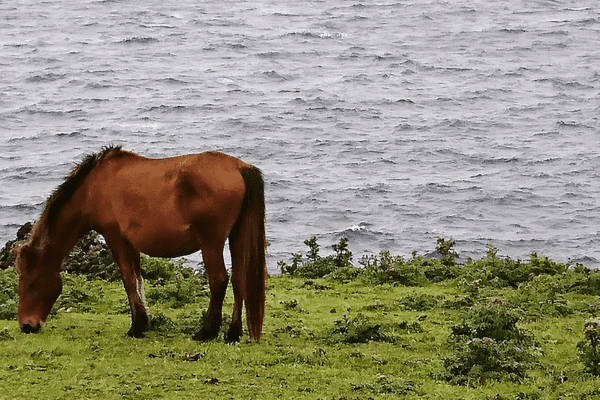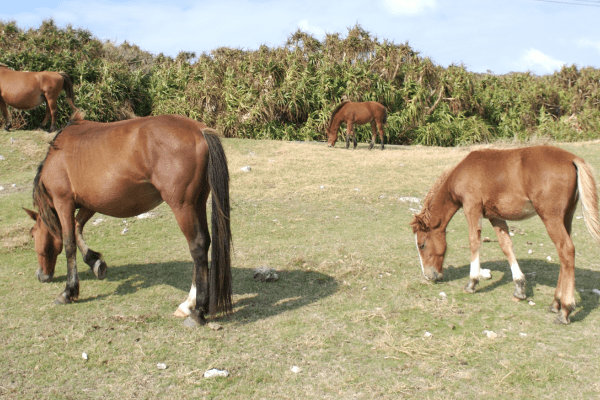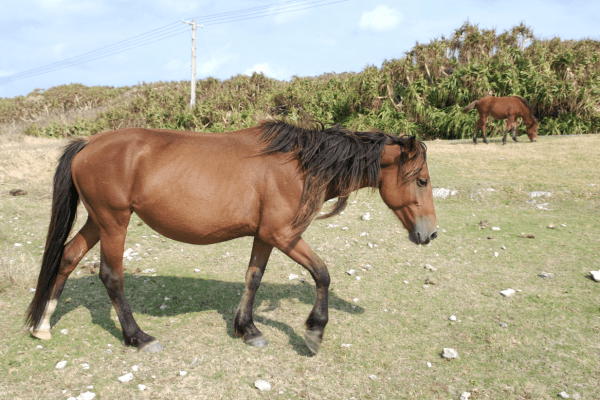The Yonaguni Horse, a distinctive equine breed native to Japan, presents a unique blend of diminutive size and surprising strength. Originating from the tranquil shores of Yonaguni Island, these horses are known for their compact yet sturdy build. In contemporary times, the breed faces a decline in numbers, a phenomenon significantly influenced by the rapid industrial advances of the 20th century.
Interestingly, despite sharing visual similarities with Japan’s Tokara and Miyako pony breeds, the Yonaguni Horse possesses a unique genetic makeup, distinguishing it from its regional counterparts. This distinct genetic identity highlights the breed’s unique role in the tapestry of Japan’s equine population.
History:
It is believed that the Yonaguni Horse, a breed covered in mysterious historical mystery and has a story that connects the cultural and technological development of Japan. This is a thorough look at their story:
Mysterious Origins
An Uncertain Lineage: exact roots of Yonaguni Horse remain a subject of debate in the field of scholarly research. The theories suggest a possible lineage that originates from Korea and specifically connected with the Cheju horses from in the Korean Peninsula, or an introduction from the southern islands around two millennia long ago.
Geographical significance: Originating from Yonaguni Island, the westernmost part of Japan The horses have developed distinctive traits adapting to the unique environment of Yonaguni Island.
Integral to Rural Japan
Agriculture Mainstay: Historically Yonaguni Horse was a mainstay of agriculture. Yonaguni Horse was a ubiquitous presence in the countryside of Japan essential to daily agriculture.
The versatility of their use They were used in different tasks, including the transportation of goods, farming especially timber, and embodying the spirit of a horse in an environment of rural life.
Impact of Industrialization
Decline in practical use The rise of industrial revolutions as well as the advent technology gradually diminished the necessity for horses in work-intensive jobs.
Reduced in breeding The practical value of these animals decreased, so did attraction in breeding these animals, resulting in the significant reduction in the population of these animals.
Preservation of Purity
Exemption from Crossbreeding the latter part of 1930, as Japan was preparing for war, numerous horse breeds were crossed to increase their strength and size to be used in military operations. The Yonaguni Horse However, the Yonaguni Horse was exempted from these programs, keeping its tiny size and pure lineage.
In spite of being eclipsed by larger breeds used for military reasons and other reasons, the Yonaguni Horse was the most local essential for a variety of tasks in the locality.
Brink of Extinction and Revival
Critical Population Decline In 1975 in 1975, the number of Yonaguni Horses alarmingly dropped to only 59.
The formation of an Preservation Committee In recognition of the crucial situation of the breed an independent association was created that was dedicated to the protection and development of Yonaguni Horse.
Community Engagement The efforts of the committee paid off by reviving local enthusiasm in breeding horses, which led to an increase in the number of horses.
Cultural and Touristic Emblem
The symbol for Yonaguni Island: With the turning of the millennium it was the Yonaguni Horse emerged as an iconic symbol of the island, representing its rich natural and cultural heritage.
Tourist Attraction more employed in the fields or in labor the horses now draw tourists with their unique glimpse of the island’s history and the evolution of the breed through the ages.

Physical Characteristics:
At just 120 centimeters in height The Yonaguni Horse is one of the smallest breeds of horse.
Despite their dimensions they are exceptionally strong and muscular, sporting the appearance of a taller horse that speaks at their endurance and strength.
They have a large tail and mane that provide the necessary protection from the elements. Additionally, their coats vary in colors ranging from brown to black with occasional white marks.
Cultural Significance:
The people from Yonaguni These horseback riding horses are more than horses; they are symbols of the identity of their culture and pride in their history.
They played an important part in the life of islanders, being used in agriculture as well as means of transportation. They are also used for transportation.
Yonaguni Horse Festival, held every year, is a testament to their significance. horses are celebrated with various activities, including traditional parades and races.


Conservation Efforts:
In the present, the Yonaguni Horse is considered a extremely endangered breed, with just a few hundred individuals left. Conservation efforts are being undertaken to preserve and protect this rare breed. This includes breeding programs, habitat conservation as well as raising awareness of the significance of this breed and its plight.

